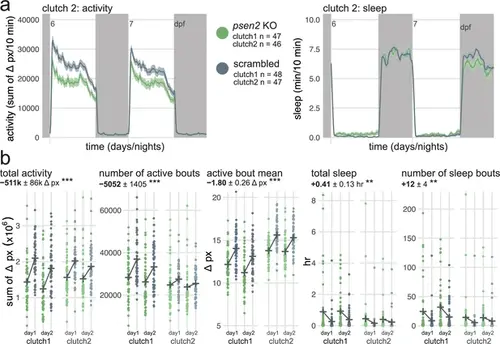Fig. 3 - Supplemental 2
- ID
- ZDB-FIG-250324-8
- Publication
- Kroll et al., 2025 - Behavioural pharmacology predicts disrupted signalling pathways and candidate therapeutics from zebrafish mutants of Alzheimer's disease risk genes
- Other Figures
-
- Fig. 1
- Fig. 1 - Supplemental 1
- Fig. 2
- Fig. 2 - Supplemental 1
- Fig. 2 - Supplemental 2
- Fig. 3
- Fig. 3 - Supplemental 1
- Fig. 3 - Supplemental 2
- Fig. 3 - Supplemental 3
- Fig. 3 - Supplemental 4
- Fig. 4
- Fig. 4 - Supplemental 1
- Fig. 4 - Supplemental 2
- Fig. 4 - Supplemental 3
- Fig. 4 - Supplemental 4
- Fig. 4 - Supplemental 5
- Fig. 5
- Fig. 5 - Supplemental 1
- Fig. 6
- Fig. 6 - Supplemental 1
- Fig. 7
- All Figure Page
- Back to All Figure Page
|
sleep/wake behaviour of psen2 F0 knockouts. (a) (left) Activity (sum of Δ pixels/10 min) of psen2 F0 knockout larvae and scrambled-injected siblings during 48 hr on a 14 hr:10 hr light:dark cycle (white background for days, dark grey background for nights). (right) Sleep (minutes per 10-min epoch) during the same experiment. Traces are mean ± SEM across larvae. This replicate experiment is called clutch 2 in Figure 3h. (b) Parameter plots for two clutches of psen2 F0 knockout larvae and scrambled-injected siblings. Each dot represents one larva during 1 day. Black crosses mark the group means. Compared to scrambled-injected siblings, psen2 F0 knockouts displaced fewer pixels (total activity, *** p<0.001) and initiated fewer swimming bouts (number of active bouts, *** p<0.001), each displacing fewer pixels in average (active bout mean, *** p<0.001). They also spent more time asleep (total sleep, ** p=0.002) and initiated more sleep bouts (number of sleep bouts, ** p=0.002) than scrambled-injected siblings. Statistics by likelihood-ratio test on linear mixed effects models. |

